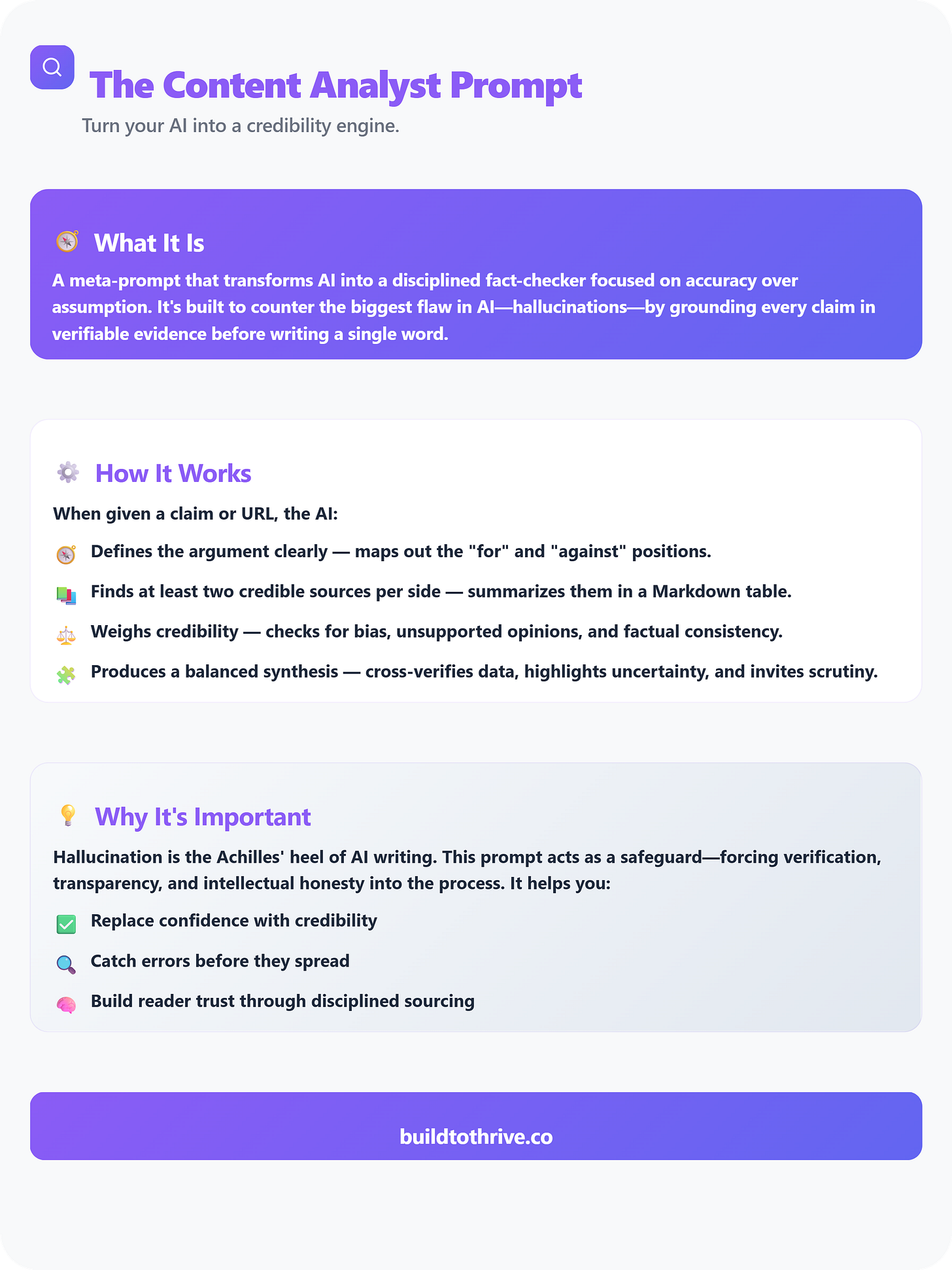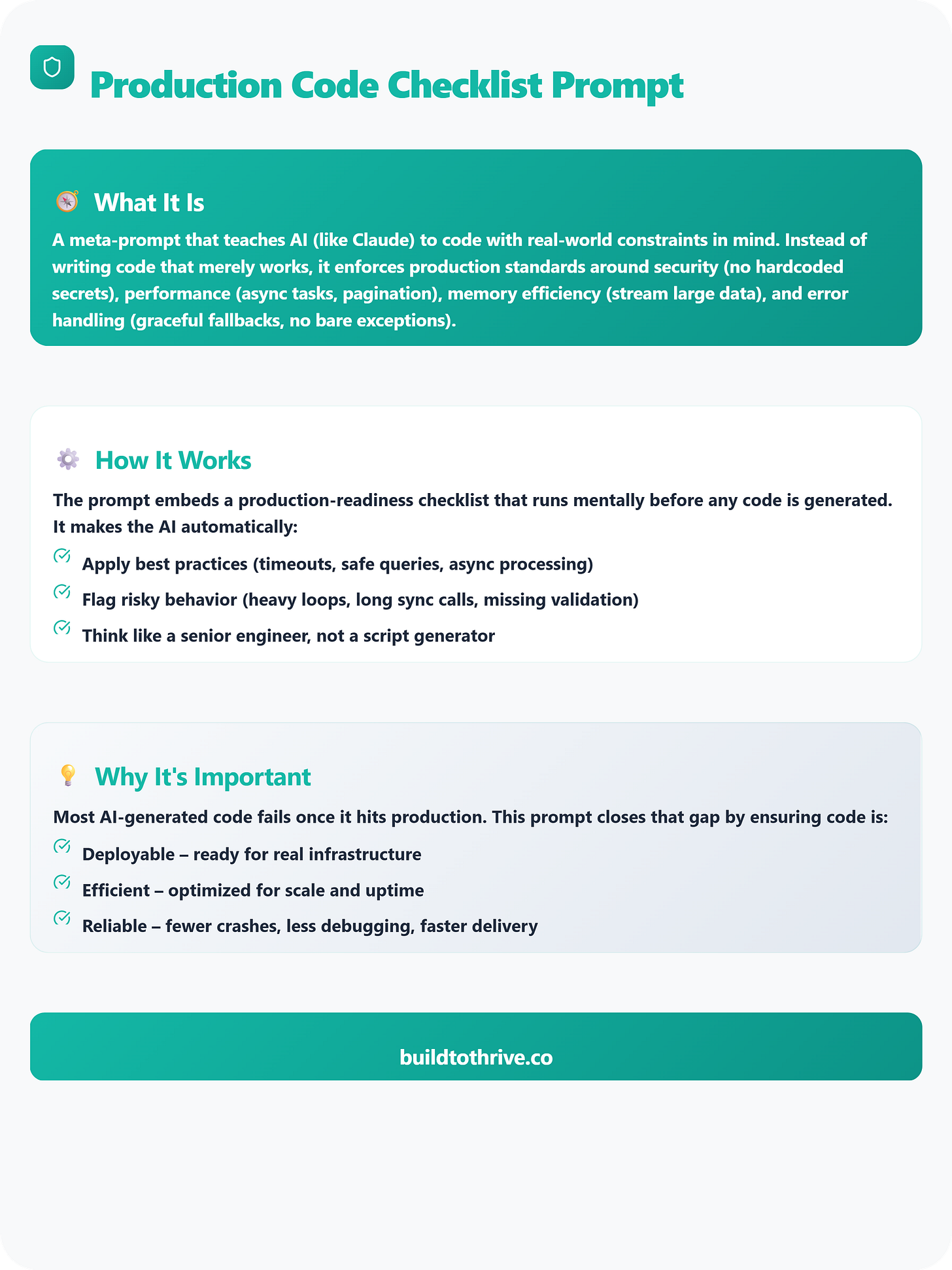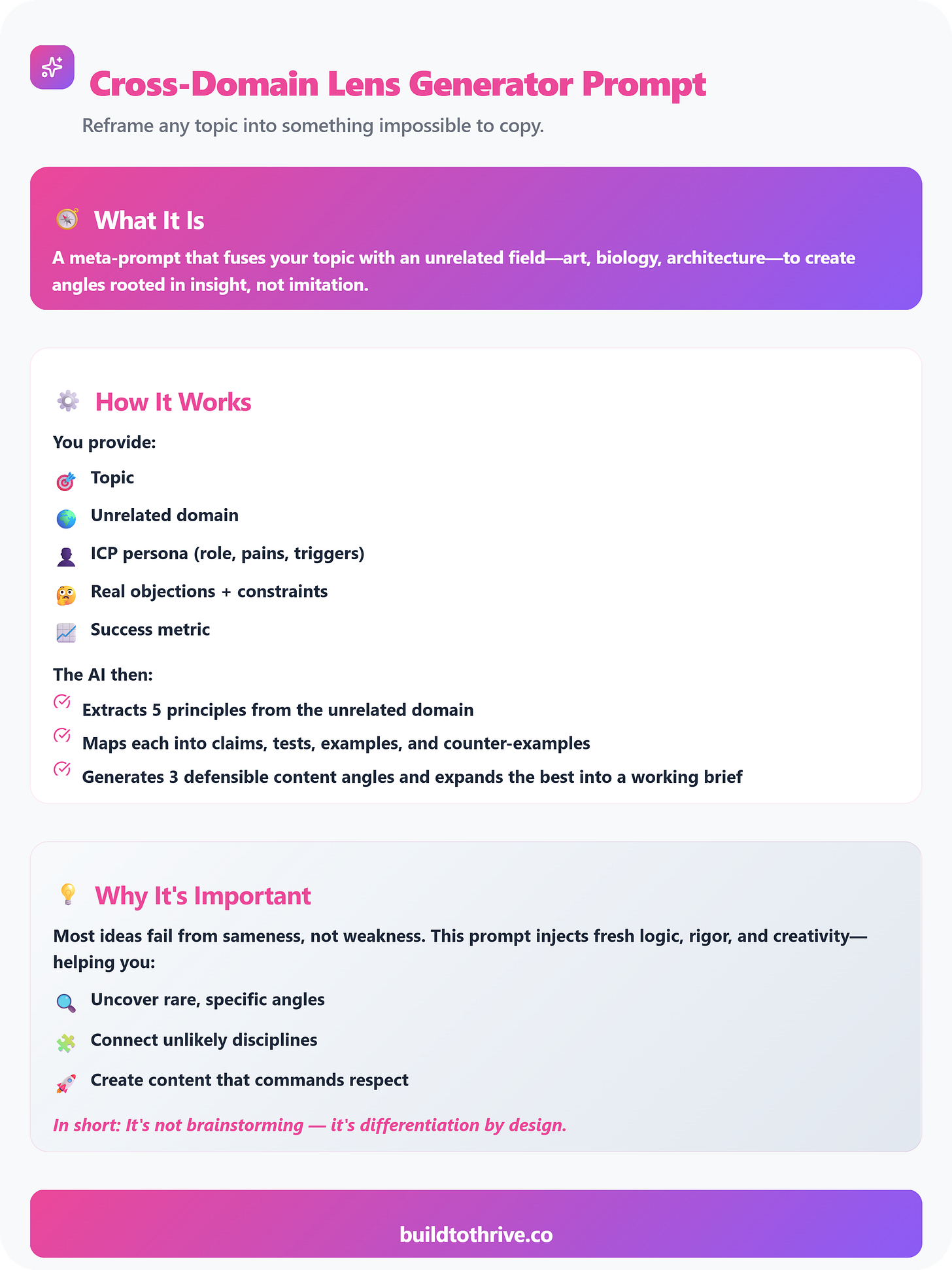Build to Thrive | The Blueprint | Week of November 3rd, 2025
Prompts, Tools and Trends to grow smarter, scale your business and stay ahead
Thank you for reading the Blueprint. It’s recently evolved into a platform where AI content creators share their best work and prompts. Consider subscribing to their newsletters to stay inspired and ahead of the curve.
Editorial Note
Building with Leverage
This week’s Blueprint is inspired by three creators who treat AI as a discipline, a way to think with more rigor, test with more clarity, and create with more reach. Raghav, Karen, and Mia each approach that craft through a different lens.
Raghav’s Content Analyst Prompt is about trust. He shows how to design AI systems that reason step by step, grounding insights in evidence to reduce hallucinations and make outputs more reliable in real business contexts.
Karen’s Production Code Checklist Prompt is about iteration. She turns experimentation into process, showing how testing and documenting AI in real workflows builds momentum and measurable progress.
Mia’s Cross-Domain Lens Generator Prompt is about perspective. She teaches AI to think across disciplines, connecting logic and creativity to uncover patterns that help teams design smarter systems.
Together, they remind us that leverage doesn’t come from scale, it comes from structure, from knowing how to guide AI, capture learning, and translate insight into action.
This week’s top AI small business stories carry that same mindset: small teams using AI to move faster, solo builders shipping full products in 30 days, and startups growing through focused, repeatable systems.
Structure creates speed. Trust creates scale. That’s the blueprint. JS
Table of Contents
PROMPTS
The Content Analyst Prompt
The Production Code Checklist Prompt
Cross Domains Lens Generator Prompt
FEATURED ARTICLE: Built to Blaze: How Ooni Turned Backyard Pizza into a $200M Global Movement
AI SMALL BUSINESS TRENDS: Top 5 curated stories of the week
BIG IDEA: Mini-sprints with AI as a multiplier
The Content Analyst
by
is a weekly newsletter by and — an AI strategist duo blending capital markets insight with product innovation. Raghav brings experience from high-frequency trading and asset management, while Ashwin draws from digital banking and insurance transformation. Together, they explore the frontier of AI breakthroughs and translate them into actionable business systems. Each edition combines cutting-edge research, real case studies, and step-by-step implementation guides that help professionals move from theory to execution — mastering prompt engineering, workflow automation, and multimodal AI for real competitive advantage.The Production Code Checklist Prompt
by
is a hands-on AI newsletter by Karen Spinner — a writer, agency owner, and casual developer documenting the real-world impact of AI across work and life.Each issue tests practical applications of AI, from everyday experiments to professional workflows, sharing unfiltered results — the breakthroughs, the failures, and the weird in-between. Karen brings the curiosity of a builder and the skepticism of a marketer, cutting through hype to reveal what AI actually does (and where it still falls short).
Cross-Domain Lens Generator Prompt
by
is a weekly newsletter by , an AI workflow designer and founder of Yahini, an AI content strategy platform that teaches systems to think strategically before they write.Each edition combines tactical depth with strategic insight—delivering complete, battle-tested AI workflows packed with real prompts, tools, and lessons from the field. Mia blends systems thinking, creativity, and sharp experimentation to show builders, founders, and operators how to harness AI without losing their human edge.
Featured article
Built to Blaze: How Ooni Turned Backyard Pizza into a $200M Global Movement
SMALL BUSINESS AI TOOLS AND TACTICS OF THE WEEK
This week’s theme is tiny teams, massive leverage. From solo builders launching full products in 30 days to lean crews using AI to punch way above their weight. Every story here proves you don’t need a big team to move fast. These are practical, real-world tactics you can swipe and run with right now. Let’s dive into the 5 that stood out.
Top 5 Curated Stories
Lean teams + AI = the new playbook for startups
Summary: Based on a blog post from Logiciel Solutions published today that shows how U.S. startups are using small, “micro” teams (3-8 people) powered by AI tools and offshore talent to hit high velocity. Logiciel Solutions
Practical takeaway: If you’re a solo founder or tiny team, pick one small, well-bounded feature or outcome and allocate 1-3 people (or freelancers) + an AI workflow (e.g., code automation, content generation). Treat it like a mini sprint: define the goal, tools, and measure outcome in 2-4 weeks.Solo founders launching full products in 30 days with no-code & AI
Summary: A piece on GenAI99 covering how in 2025 “micro-AI startups” built by single founders (or very small teams) are shipping MVPs and even revenue generating products in under a month. genai99.com
Practical takeaway: If you’ve been sitting on an idea, choose a narrow niche, pick a no-code + AI stack, set a 30-day launch plan (idea → prototype → live pricing). The barrier is way lower now. You don’t need to wait for full funding or big dev teams.Up-to-date AI tool reviews are your secret weapon
Summary: A case-study style blog from PerfectStack.ai shows how founders used curated, recent reviews of AI tools (not just top lists) to avoid costly mistakes and roll out automation faster. perfectstack.ai
Practical takeaway: When picking a new tool, don’t just scan top-5 lists. Ask: When was this review published? Does it cover pricing changes & integrations? Set aside 1 hour this week to audit the tools you rely on and swap or combine one outdated tool for a better alternative.Micro-teams + AI = future of high-performance startups
Summary: A piece from Forbes Technology Council argues that in the AI era, the winning org structure is small, agile, empowered teams backed by AI — not big hierarchies. forbes.com
Practical takeaway: If you have a team of 3-5 (or are solo), carve out one product/domain “area” you own fully (e.g., onboarding flows, customer success automation). Apply AI to amplify that area (e.g., automate responses, reporting). Schedule a weekly “team stand-alone” check-in just for that area.The expansion playbook for startups—not massive scale, smart expansion
Summary: seven proven expansion strategies for startups that emphasize scalable business models, not just headcount growth. thehartford.com
Practical takeaway: This week, write a one-page “scale check” for your business: What’s your model? What’s repeatable? What’s scalable without adding headcount? Then pick one lever you can pull (e.g., better onboarding, a self-service upgrade, a micro-product) to move that needle.
Big Idea: Mini-sprints with AI as a multiplier
Here’s a tactic you can deploy this week: run a 7-day mini-sprint where you pick one meaningful output, apply an AI stack, and ship.
Why it matters for small teams:
You don’t have big resources; this keeps things tight and focused.
AI tools are now accessible, cheap, and can accelerate output.
You learn fast and either win quickly or pivot without heavy cost.
How to do it:
Pick your target. Define one clear goal: e.g., “automate customer follow-up emails,” “launch a micro-feature for X users,” or “create a self-service upgrade flow.”
Assemble your sprint team. It could be you + one freelancer + an AI tool (e.g., for text generation, workflow automation). Keep it max 3 people.
Define your tool-stack. Choose an AI tool you’ll use, pick a no-code automation platform (like Zapier, Airtable, etc.), and integrate.
Set timeline & metrics. 7 days. End the sprint with “shipped” not “perfect.” Choose one metric: email open rate, upgrade conversion, feature activation.
Review & iterate. After day 7, check results, decide whether to scale that sprint into wider rollout or pivot.
Document what you learned. Use your sprint results as input for your next sprint — keep momentum high.
Why this works right now: The articles above show micro-teams + AI are the winning formula. By running small, focused sprints, you stay agile and avoid burnout or big investments. The review piece reminds us that tool selection matters. And the growth model piece shows that scale for small teams comes not via headcount but via repeatable workflows.
If you do this, you’ll exit the week with something live, measurable, and scalable — ideal for a founder or micro-team.
Until the next edition
Build smarter. Build with purpose. Build to Thrive.
I use this space to share ideas and voices that help founders and creators think more clearly, act more intentionally, and build systems that last.
My work focuses on helping entrepreneurs bring order to growth and clarity to complexity, moving from chaos to control, and from control to sustainable growth.
If you are struggling with growing your company, here are some ways I can help:
Setup a FREE 20 minute call with me directly to talk about possibilities Click Here
Visit my page for more information about the program Click Here
Or message me














Thank you for sharing.
This sounds so interesting! The article provides a very rich perspective thanks to the ideas from the AI experts Raghav, Karen and Mia. Definitely recommend it💡